In this issue:
Tomato Leaf Diseases
Squash Bug
Powdery Mildew of Cucurbits
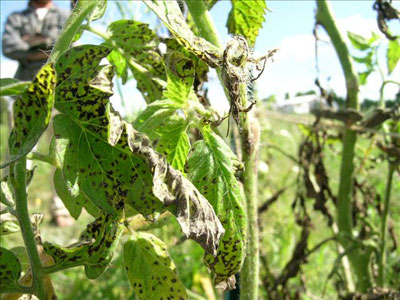 |
| Septoria leaf spot |
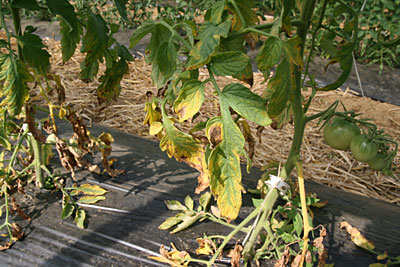 |
| Early blight |
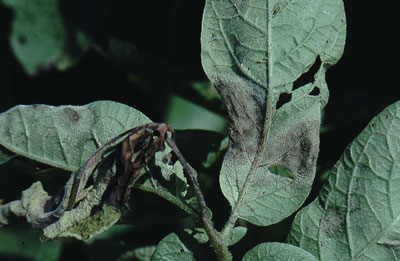 |
| Late blight |
Some farmers and gardeners like to use the same ground year after year for their tomatoes. Often this works, but often it doesn’t – most commonly because of a few tomato diseases that overwinter on crop debris. The two most common diseases in the Northeast that leads to a tomato crop failure are Septoria leaf spot and early blight. These are commonly confused with it late blight.
Symptoms
All three of these diseases are primarily foliage diseases. The pictures show that early blight is easily diagnosed by the concentric, target-like rings that form in the leaf lesions. Septoria leaf spot has smaller, more circular spots that later develop a tan center. Both early blight and septoria leaf spot usually start on the lowest leaves and spread up the plant. With early blight, the infected areas of the leaf coalesce, and the whole leaf turns yellow and then dries and falls off. With septoria, the leaf spots become numerous, and infected leaves turn slightly yellow and then brown.
Late blight appears on tomato leaves as pale green, water-soaked spots, often beginning at leaf tips or edges. The circular or irregular leaf lesions often are surrounded by a pale green border that merges with healthy tissue. The leaf does not really turn yellow. Lesions enlarge rapidly and turn dark brown to purplish-black. During periods of high humidity and leaf wetness, a cottony, white mold usually is visible on the leaf underside, at the edges of lesions. In dry weather, infected leaf tissues quickly dry, and the white mold disappears. If you suspect late blight but do not see the symptoms, take a leaf that is infected, put it in a plastic bag, and the cottony white mold will appear.
Fruit rotting from early blight usually comes later in the season and is centered around the stem end of the ripe tomatoes. Late blight develops on green tomato fruit, resulting in large, firm, brown, leathery-appearing lesions, often concentrated on the sides or upper fruit surfaces first, but later taking the whole tomato and turning it into a brown golf ball. If conditions remain moist, abundant white mold will grow on the lesions, and secondary soft-rot bacteria may follow, resulting in a slimy, wet rot of the entire fruit. Septoria leaf spot rarely infects the fruit.
Disease Cycles
Early blight and septoria leaf spot pass dormant periods on any plant debris that has not fully decomposed, including seeds. Initial infection typically occurs from spores produced on the overwintering fungus and splashed onto new tomato plants. Later, spores are produced on any infected tissue and spread by splashing water, wind, machinery and by hand.
Late blight requires a living host between seasons. In the Northeast the potato tuber is usually the only source of inoculum, since tomatoes do not live through our winters. Potatoes that are not harvested and turn into volunteer sprouts, or sprouting tubers in cull piles, may be the initial sources of sporangia that can be spread miles in the wind. Usually, late blight reaches the Northeast by spores blowing in the wind from far away. Sporangia can live for only one to two hours in sunlight, but can live much longer on cloudy days and so in cloudy weather spores can travel long distances. Germination takes place just a few hours after landing on wet tissue. If there is no moisture the spores are likely to die before they germinate. If the disease is successful, then new spores are produced on infected tissue and the disease can spread like wild fire in damp weather. Each lesion can produce 100,000 to 300,000 sporangia that end up blowing in the wind.
Management
The first step in controlling these diseases is good sanitation. On a small scale, diseased plants should be removed from the field and destroyed. On a large scale, plow deeply in the fall to bury debris. Sanitation is particularly important for late blight. Cull potatoes must freeze, be crushed or composted or buried at least 2 feet deep in order to eliminate the fungus. In the spring be sure to scout for potato volunteers. Late blight is not carried on tomato seed. Septoria leaf spot and early blight can be carried on seed, but usually tomato seed from reputable sources is screened and/or treated to eliminate the risk. Saving your own seed is a risk and you should learn how to deal with this problem.
Don’t let leaf tissue remain wet for prolonged periods; this helps a great deal. Promote good air circulation by orienting the rows in the prevailing wind direction, avoiding wind breaks and controlling weeds. Irrigate early in the morning rather than in the late afternoon so that the plants dry quickly in the sun.
Rotating with crops outside of the tomato family for two years will help with early blight and Septoria, if you can control other sources of inoculum. Eliminate non-crop plants in the tomato family that can carry these diseases if you can. These include nightshade, bittersweet, ground cherry, horsenettle and petunia.
Scouting for “hot spots” in fields of otherwise healthy plants and removing diseased leaves may work if you catch things early enough. However, if 5 to 10% of the foliage in the “hot spot” is infected, the disease probably has spread already even though there may be no symptoms.
Everyone has favorite tomato varieties, but you can plant some resistant ones as a backup measure. The cultivars ‘Mountain Fresh,’ ‘Mountain Supreme’ and ‘Plum Dandy’ have resistance to early blight. Seed companies keep coming out with new resistant varieties so keep your eyes out.
The product Serenade, a natural fungicidal strain of the bacteria Bacillis subtilis, is registered for early and late blight. It works as a foliar spray that then colonizes the leaf surface and keeps the pathogens from germinating. It also outcompetes them for space and food on the leaf. There has been variable success that you can read about in the Resource Guide to Organic Insect and Disease Management.
As a last resort, copper fungicides are permitted in organic production. Because of the inert ingredients, not all brands are allowed for use in certified organic production. Many brands have been reviewed and listed by OMRI (Organic Material Review Institute), including Basic Copper 53, Champ WG, COCS WP, and NuCop 50 DF. Kocide is not approved. Remember, overuse of copper can lead to excess levels in your soil. MOFGA requires that certified growers who use copper monitor levels using soil tests.
If you need to go the copper route, scout carefully for symptoms and begin sprays at the first signs. Then repeat applications on about a weekly schedule to ensure that new plant tissue is covered.
Top
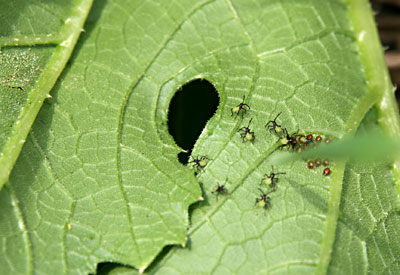 |
| Squash bug hatch |
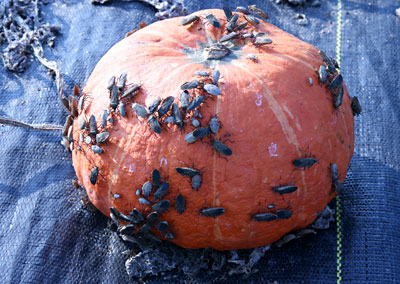 |
| Squash bug adults and older nymphs |
SQUASH BUG
Squash bugs are bound to show up soon. Squash bugs are serious pests of pumpkins and squash throughout North America. Damage and survival are low on watermelon, very low on cucumber and muskmelon, and highest on squash and pumpkin. Both adults and nymphs feed by inserting their beak and sucking juices from plant tissue. Toxic saliva injected during feeding causes foliage to wilt, then leaves turn black and die; the severity of this damage is directly related to density of squash bugs on each plant. Often I get calls by growers who believe they have a disease. Later in the season, squash bugs may feed on the fruit, causing them to collapse or become unmarketable.
Adults are 0.5 to 0.75 of an inch long, flattened and grayish-brown. They hibernate in trash in and around the garden for the winter and emerge in the early summer to feed a bit and lay eggs. Eggs are laid in clusters usually on the underside of leaves and are orange when first laid, but turn bronze-colored before they hatch. The wingless nymphs are similar in appearance to adults, and are whitish when small, with a brown head, and grayish white when larger with black legs. There is one generation per year in the Northeast.
Black plastic, straw mulch, and reduced tillage systems encourage higher populations, probably by providing good hiding places. Squash bug numbers are reduced by clean cultivation in the fall, and crop rotation. Infestation is delayed by row covers. If possible, rotate cucurbit crops between fields as far apart as possible. Keep headlands mowed and free of trash to reduce overwintering sites.
Squash bugs are unusually difficult to control with insecticides. Scout undersides of leaves for squash bug adults and eggs. Crush the eggs. You may not want to crush the bugs as they stink when you do.
If you miss some eggs and have to spray, time squash bug sprays to kill young nymphs just after hatch, because this stage is the easiest to control (see photo in web version). Treat late in the day when the flowers are closed to reduce risk to bees. Neem products have proved effective.
For adult bug control, insecticides applied to the base of the plant are most effective, possibly because bugs tend to cluster. But, squash bugs are virtually impossible to control later in the season when nymphs are large and the canopy is dense.
(Source material from New England Vegetable Management Guide; Handbook of Vegetable Pests, A Capinera; ATTRA. Adapted by Andy Cavanagh & R Hazzard, UMass Extension, and modified for this Pest Report by me)
Top
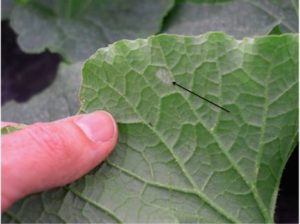  |
| Powdery mildew |
POWDERY MILDEW OF CUCURBITS
Powdery mildew is a common disease of pumpkins and winter squash. All cucurbits are susceptible, but many common cucumber and melon varieties are resistant. The disease can cause infected leaves to die prematurely, reducing yields and lowering fruit quality, especially taste. Winter squash from diseased plants won’t store as long as fruits from healthy plants.
The fungus that causes the disease does not overwinter in Maine. Spores blow up every year from southern overwintering sites. If they arrive late in the season, you may not need any control because the fruit reach maturity before much leaf tissue is lost. But if the disease arrives in early to midsummer, exercise some control or you may have no leaves by mid-August, and poor tasting squash.
Powdery mildew has not been reported to me yet this season, but be ready. Go out and scout. Check upper and lower surfaces of leaves of older plants every few days starting now. The first symptoms usually are tiny white, powdery fungal patches on the undersides of older leaves. Yellow spots may form opposite these, on the upper leaf surfaces. If powdery mildew comes here early enough to warrant spraying, it is important to begin management when you first see signs, tiny spots. Once the leaves have large patches of the powdery growth it is too late because the pathogen is well established inside the leaf.
No products with systemic activity (products that move through the plant) are approved for organic production, and applying fungicide to the lower leaf surface, where the pathogen is also thriving, is difficult. In experiments, foliar applications of sulfur have been more effective than most other organic products for powdery mildew, apparently because sulfur deposited on the upper leaf surface can volatilize and be redistributed to the lower surface. Sulfur can be phytotoxic on melons, especially if applied when temperatures are hot.
ATTRA (National Sustainable Agriculture Information Service, www.attra.ncat.org) reports that a single spray application (to runoff) of 0.5 percent baking soda (wt./vol. with water), plus 0.5 percent (vol./vol.) of a summer weight horticultural oil (ex. JMS Stylet Oil) almost completely inhibited powdery mildew on heavily infected pumpkin foliage; while baking soda without the oil was ineffective, and a 2 percent (wt./vol. of water) solution of baking soda damaged the leaves. But, remember if you are a commercial grower then you must be using EPA registered pesticides and not homemade concoctions.
